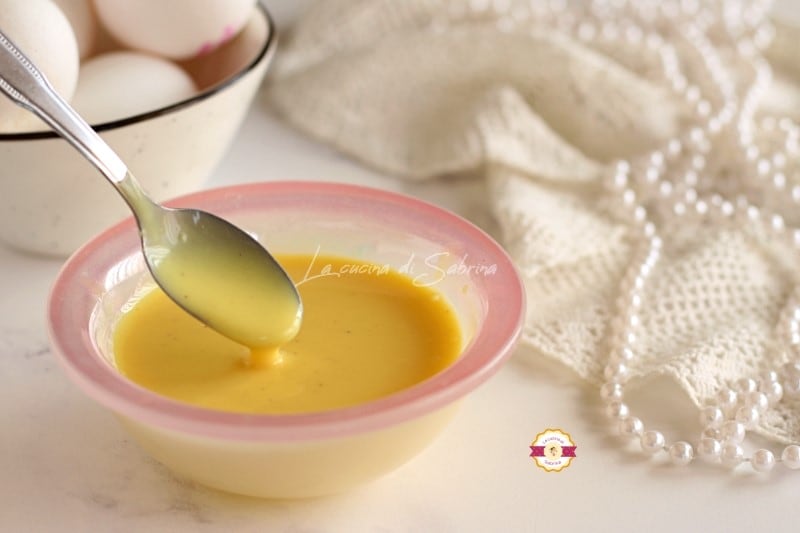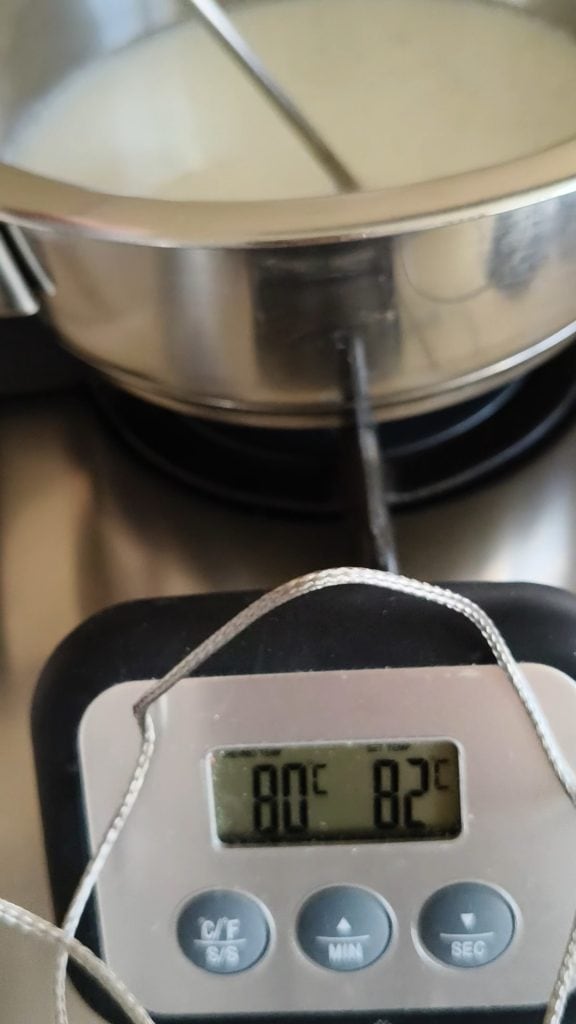The vanilla custard is a timeless classic of pastry, a creamy and refined dessert that captivates with its velvety texture and enveloping aroma. Used as a base for many dessert preparations, from fruit cakes to delicious cream cups, this delightful custard is a real pleasure for the palate.
The difference between custard and pastry cream is that there are no flours or starches here to give structure, and thus the custard is very similar to a sweet sauce. In fact, it is often served to give a touch of sweetness to fruit, or poured hot over some desserts, making them instantly elegant and refined on the palate.
So, without flours or starches, cooking is very important, which should not exceed 185°F and should be continuously stirred to prevent the eggs from curdling, turning into scrambled eggs.
To know when the custard is ready, if you do not have a thermometer, there are some tricks that I will explain later; in the meantime, get eggs, milk (or milk and cream), sugar, and vanilla and read the vanilla custard recipe. But first, take a look at the other interesting recipes and remember to read the tips.
READ THE TIPS AT THE END OF THE RECIPE IF YOU DON’T HAVE A THERMOMETER.
OTHER INTERESTING RECIPES:

- Difficulty: Medium
- Cost: Economical
- Preparation time: 3 Minutes
- Portions: 2People
- Cooking methods: Slow Cooking, Stove
- Cuisine: Italian
- Seasonality: All Seasons
- Energy 99.47 (Kcal)
- Carbohydrates 6.77 (g) of which sugars 6.72 (g)
- Proteins 2.03 (g)
- Fat 7.33 (g) of which saturated 1.39 (g)of which unsaturated 1.64 (g)
- Fibers 0.00 (g)
- Sodium 3.94 (mg)
Indicative values for a portion of 35 g processed in an automated way starting from the nutritional information available on the CREA* and FoodData Central** databases. It is not food and / or nutritional advice.
* CREATES Food and Nutrition Research Center: https://www.crea.gov.it/alimenti-e-nutrizione https://www.alimentinutrizione.it ** U.S. Department of Agriculture, Agricultural Research Service. FoodData Central, 2019. https://fdc.nal.usda.gov
Ingredients
- 1.4 oz egg yolks
- 0.21 cups whole milk
- 0.21 cups fresh liquid cream
- 0.88 oz sugar
- vanilla
Tools
The infrared thermometer is very useful for taking the temperatures of both doughs and creams and is also very useful when roasting in a saucepan.
The probe thermometer also works very well for these functions.
- Thermometer
Steps
To quickly cool the vanilla custard, use a cold container placed in the freezer at least 10 minutes before starting.
Break the egg yolks into a container (set the whites aside for other preparations, like this).

Add the sugar.

With a fork or hand whisk, beat the egg yolks and sugar well.

Put the milk and cream mixture on the stove, add the vanilla, and let them heat without boiling. The temperature should reach about 185-194°F; this way we are sure that the whey proteins will help those of the yolks to form the gel. Turn off the stove then, to prevent the temperature from going beyond 194°F.

Pour one or two tablespoons of milk into the yolk and sugar mixture, quickly dissolve.

Pour the yolk, milk, and sugar mixture into the milk, mix well, and turn on the stove at low heat; stir continuously with a spoon or spatula because there’s no need to incorporate air.

Constantly monitor the temperature if using a thermometer and, when it reaches between 180°F and 185°F, turn off. In the absence of a thermometer, perform the coating test, i.e., dip a spoon into the custard and check that it leaves a coating without slipping.

Transfer the vanilla custard to the cold freezer container and stir to lower the temperature by a few degrees. Cover with cling film in contact and transfer to the fridge until ready to use.

Use the custard to accompany your desserts.

Tips:
If the custard doesn’t cool quickly, it might form lumps. In this case, you can strain it or blend it with an immersion blender. It won’t be the same, but it will definitely still be good to eat.
In the absence of a thermometer, another way to test if the custard is ready is to dip a spoon into the custard and slide a finger along the back. If the custard leaves a trail, it means it’s ready.
In any case, the custard is ready when it begins to touch the boiling point, but it should never come to a full boil, as this could cause the eggs to break
In any case, the custard is ready when it begins to touch the boiling point, but it should never come to a full boil, as this could cause the eggs to break
Variations:
Besides vanilla, custard can also be flavored with orange or lemon zest: after washing and drying the chosen citrus, peel the zest without the white part and immerse it in the milk that will be heated and then removed before adding the yolks.

